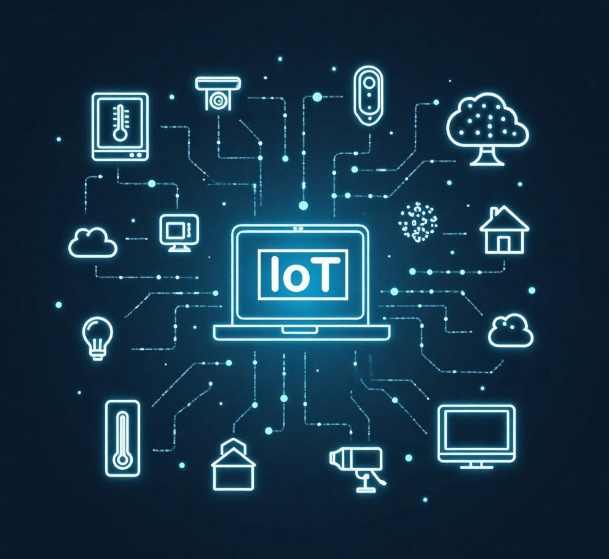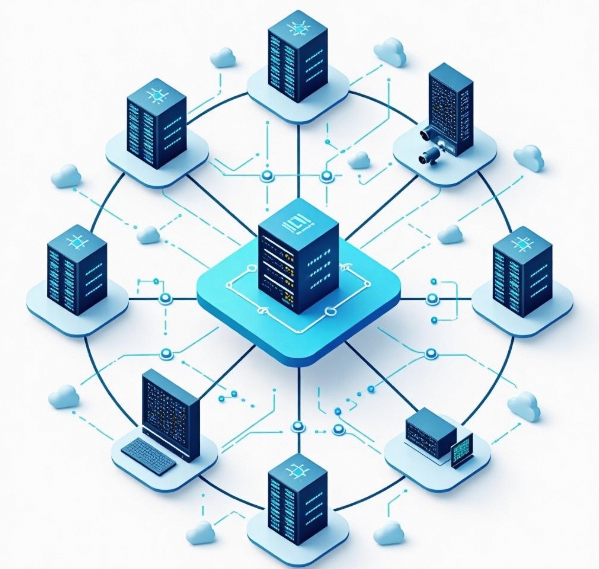Data Storage and Cloud Computing Solutions in IoT Development
- latest articles
- 1.DApp Development & Customization: Merging Diverse Market Needs with User Experience 2.Analysis of the Core Technical System in DApp Project Development 3.How to achieve cross-chain interoperability in Web3 projects? 4.How does the tokenization of points reconstruct the e-commerce ecosystem? 5.How to Set and Track Data Metrics for a Points Mall? 6.What is DApp Development? Core Concepts and Technical Analysis 7.Inventory of commonly used Web3 development tools and usage tips 8.Development of a Distribution System Integrated with Social E-commerce 9.Six Key Steps for Businesses to Build a Points Mall System 10.What is DApp Development? A Comprehensive Guide from Concept to Implementation
- Popular Articles
- 1.Future Trends and Technology Predictions for APP Development in 2025 2.Analysis of the DeFi Ecosystem: How Developers Can Participate in Decentralized Finance Innovation 3.From Zero to One: How PI Mall Revolutionizes the Traditional E-commerce Model 4.DAPP Development | Best Practices for Professional Customization and Rapid Launch 5.How to Develop a Successful Douyin Mini Program: Technical Architecture and Best Practices 6.Recommended by the Web3 developer community: the most noteworthy forums and resources 7.From Cloud Computing to Computing Power Leasing: Building a Flexible and Scalable Computing Resource Platform 8.Shared Bike System APP: The Convenient Choice in the Era of Smart Travel 9.How to Create a Successful Dating App: From Needs Analysis to User Experience Design 10.From Design to Development: The Complete Process of Bringing an APP Idea to Life
With the rapid advancement of technology, Internet of Things (IoT) technology has become an essential part of modern life. From smart homes to industrial automation, IoT applications are increasingly widespread, and data storage and cloud computing are among the core technologies supporting IoT development. In IoT systems, devices continuously collect and transmit vast amounts of data through sensors, network connections, etc. This data requires effective storage and processing to enable intelligent analysis, decision-making, and feedback. Cloud computing, as an efficient, flexible technology with powerful computing and storage capabilities, provides an ideal infrastructure for realizing IoT.
I. Challenges of IoT and Data Storage
In IoT applications, the dramatic increase in data volume is a challenge that cannot be ignored. As the number of devices continues to grow, the speed and scale of data generation far exceed the capabilities of traditional data processing systems. Unlike ordinary application scenarios, IoT data characteristics mainly include the following:
Massive and Continuously Growing Data Volume
The proliferation of IoT devices means that vast amounts of data are generated every second. For example, in a smart home system, devices such as temperature and humidity sensors, door lock monitors, and cameras continuously send real-time data to the central processing system. Such enormous data volumes require robust storage and processing capabilities to handle.Diverse and Varied Data Types
IoT devices generate a wide variety of data, including simple numerical data like temperature and humidity, as well as complex multimedia data such as videos and images. The storage requirements for these data differ, and traditional relational databases cannot meet the various data formats and query needs.Frequent Updates and Strong Real-Time Requirements
IoT applications often require real-time data acquisition and immediate processing. This demands that data storage solutions not only have high throughput but also ensure low latency and high availability of data.Distributed Nature
The distributed nature of IoT devices requires data storage solutions to adapt to distributed environments, avoiding system downtime or data loss due to single points of failure.
II. Solutions for IoT Data Storage
To address the above challenges, IoT data storage solutions typically employ advanced technologies such as distributed storage and cloud storage. The following are several common IoT data storage solutions:
1. Distributed Storage Systems
A distributed storage system is a storage solution that disperses data across multiple nodes. This approach offers high fault tolerance, scalability, and availability, meeting the data storage needs generated by the vast number of devices in IoT. Key advantages of distributed storage systems include:
High Scalability
As IoT devices increase, distributed storage can flexibly expand storage capacity, supporting horizontal scaling of data. Adding new nodes does not affect the operation of the existing system.High Fault Tolerance and Reliability
Distributed storage systems redundantly back up data across multiple nodes. If one node fails, data can still be recovered from other nodes, ensuring high system reliability.Load Balancing
Through distributed storage, data read and write requests can be evenly distributed across multiple nodes, improving overall system performance.
2. Cloud Storage Solutions
Cloud storage uses cloud computing platforms to store data on remote servers, allowing users to access and manage data via the internet. Cloud storage can provide virtually unlimited storage space without the need for users to purchase and maintain expensive hardware. For IoT, the advantages of cloud storage solutions are particularly prominent:
On-Demand Scaling
IoT application data volumes often fluctuate significantly. Cloud storage can scale capacity on demand, avoiding the difficulties of capacity planning in traditional storage solutions.Convenient Data Access
IoT devices and applications can access cloud-stored data anytime, anywhere via the internet, ensuring data timeliness and availability.High Availability and Security
Cloud storage platforms typically feature high availability and fault tolerance mechanisms, ensuring data security through measures like data encryption and identity verification.
3. Edge Computing and Data Storage
Edge computing is a computing model that extends computing, storage, and network resources from the cloud to near physical devices. In IoT applications, edge computing can effectively reduce data transmission latency, alleviate the burden on central servers, and optimize data storage and processing efficiency. Edge computing data storage solutions typically include:
Local Storage
Part of the data is stored on the device side, especially for data with high real-time requirements. Devices can cache data locally first and then upload it to the cloud or central server as needed.Hybrid Cloud Storage
By combining edge computing and cloud storage, data can undergo preliminary processing and storage locally, while complex computations and long-term data storage are handled by the cloud.
The combination of edge computing and data storage enables IoT systems to not only respond quickly to real-time data but also save bandwidth resources while reducing latency.
III. Applications of Cloud Computing in IoT
The application of cloud computing in IoT is indispensable, providing efficient computing power, storage capacity, and data processing capabilities for IoT. Through virtualization technology, distributed computing, and big data analysis, cloud computing significantly enhances the processing power and flexibility of IoT systems.
1. Data Storage and Management
Cloud computing can provide elastic storage for IoT applications, supporting the storage and management of massive data. With cloud storage, users do not need to worry about insufficient storage space or issues like redundant backups and disaster recovery. Cloud service providers typically offer various storage types based on user needs, including object storage, block storage, and file storage, allowing users to choose the appropriate storage method according to data characteristics.
2. Data Processing and Analysis
The data generated by IoT devices is vast and complex, and cloud computing platforms provide powerful data processing and analysis capabilities. Leveraging cloud computing, IoT can achieve real-time data analysis and big data processing. For example, cloud computing platforms can use data mining techniques to analyze user behavior patterns, thereby optimizing device performance and user experience.
3. Integration of Artificial Intelligence and IoT
Cloud computing not only supports data storage and processing but also integrates with artificial intelligence (AI) technology to provide intelligent decision-making support for IoT applications. Through cloud computing platforms, AI models can be trained and optimized on big data, enabling intelligent prediction, analysis, and optimization. For instance, in smart manufacturing, IoT devices can monitor production line status, and cloud computing and AI can analyze equipment failure data to provide early warnings and optimize production processes.
4. Elastic Computing Resources
In IoT systems, data processing volumes and computing demands often change. Cloud computing platforms provide elastic computing resources that can be scaled up or down as needed. Whether it's handling large amounts of data during peak times or lightweight tasks during off-peak periods, cloud computing platforms offer flexible resource scheduling, avoiding the waste of computing resources common in traditional IoT systems.
IV. Security Issues in IoT Data Storage and Cloud Computing
Although cloud computing and data storage provide strong support for IoT, security issues remain a challenge that cannot be overlooked when using these technologies. The vast number of IoT devices and the complexity of data transmission paths make data security and privacy protection particularly important. The following are some common IoT security issues and countermeasures:
1. Data Transmission Security
Data transmission between IoT devices and cloud computing platforms is typically conducted over wireless networks, which are prone to risks such as network attacks and data theft. To protect data transmission security, encryption technologies like SSL/TLS protocols should be employed to ensure data is not intercepted during transmission.
2. Identity Authentication and Permission Management
In IoT systems, device and user identity authentication is key to ensuring system security. Through multi-factor authentication, role-based access control, and other methods, ensure that only authorized devices and users can access sensitive data.
3. Data Storage Encryption
Data stored in the cloud may face risks of unauthorized access and leakage; therefore, stored data needs to be encrypted. Using strong encryption algorithms like AES can effectively protect data confidentiality.
4. Preventing DDoS Attacks
Distributed Denial of Service (DDoS) attacks are a common security threat to IoT devices. To prevent DDoS attacks, IoT devices can employ measures such as traffic filtering and load balancing to enhance the system's resistance to attacks.
Conclusion
With the continuous development of IoT technology, data storage and cloud computing solutions will become key to the success of IoT applications. Cloud computing not only provides powerful data storage and computing capabilities but also integrates with IoT devices to achieve more intelligent and efficient system operations. In the future, as IoT devices become increasingly widespread, data storage and cloud computing solutions will further drive the development of IoT and bring more innovation and transformation to various industries.
-

How to Use IoT Development to Enhance Supply Chain Efficiency
With the rapid development of the global economy and the deepening of digital tr···
-

Development and Innovation of the Internet of Things in the Healthcare Sector
With the rapid advancement of information technology, the Internet of Things (Io···
-

Data Storage and Analysis Methods in IoT Development
The Internet of Things (IoT) is one of the most revolutionary innovations in tod···

 Blockchain
Blockchain












